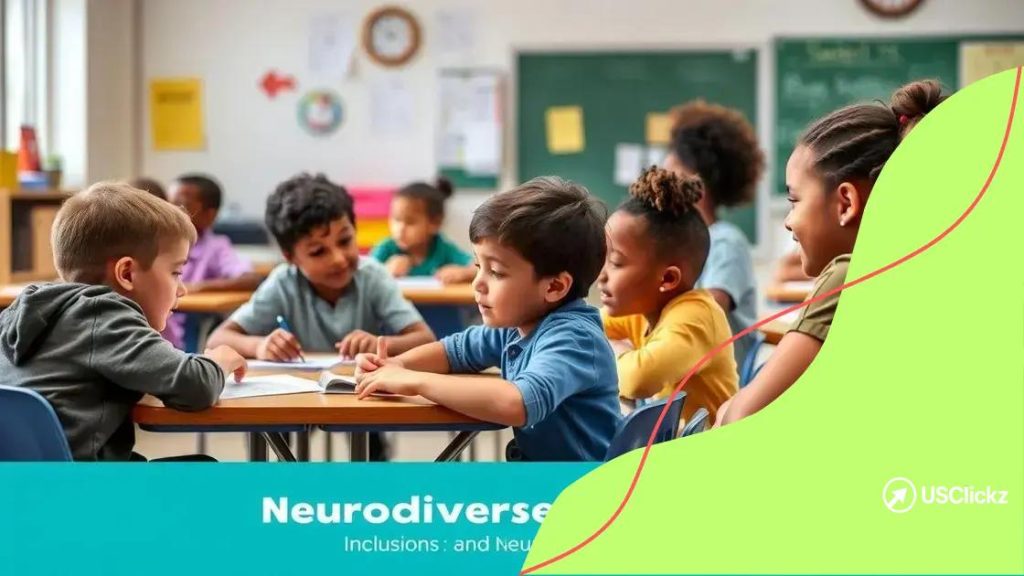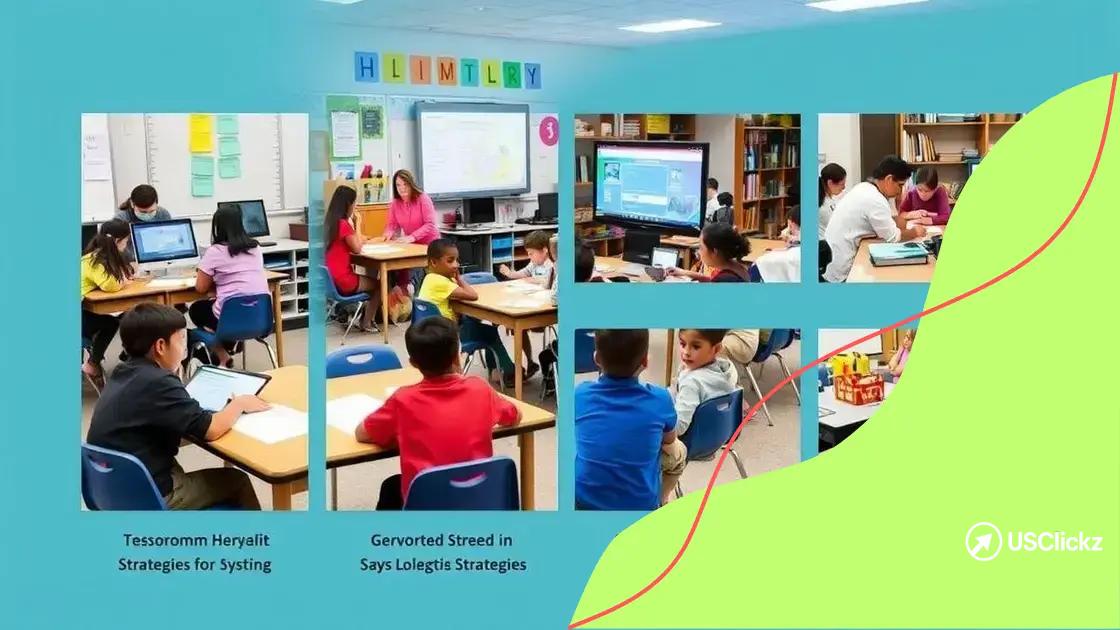Supporting neurodiversity in schools: why it matters

Anúncios
Supporting neurodiversity in schools involves implementing effective teaching strategies, fostering collaboration with families and professionals, and creating an inclusive culture that values every student’s unique abilities.
Supporting neurodiversity in schools is crucial for fostering an inclusive learning environment where every child can thrive. Have you ever wondered how different teaching methods can make a significant difference in students’ lives? Let’s explore this together.
Understanding neurodiversity in education
Understanding neurodiversity in education is essential for recognizing the unique strengths and challenges that neurodiverse students may face. Neurodiversity recognizes that variations in brain function and behavior are natural and should be valued as part of human diversity. In schools, fostering an understanding of neurodiversity can help create an inclusive environment where all students feel valued.
What is Neurodiversity?
Neurodiversity encompasses various neurological differences, including autism spectrum disorder, ADHD, dyslexia, and more. Understanding these differences is vital in education.
Importance of Acceptance
Accepting neurodiverse learners is crucial. Acceptance encourages self-esteem and promotes social interactions that enhance learning. Here are key reasons why acceptance matters:
- Improved mental health for students.
- Enhanced peer relationships.
- Higher academic performance.
When schools embrace neurodiversity, they pave the way for innovative teaching methods. This can include differentiated instruction tailored to individual learning needs. For instance, visual aids can greatly benefit students with dyslexia.
Teachers can also incorporate flexible seating arrangements, allowing students to choose their preferred learning environments. This flexibility can lead to greater engagement and focus.
Encouraging collaborative projects helps students learn from each other. By working in teams, neurodiverse students can share their unique perspectives, fostering a rich learning experience. The classroom becomes a space for creativity, where every voice is heard and valued.
Incorporating neurodiversity awareness training for teachers can further enhance understanding. Professional development can equip educators with strategies to support neurodiverse learners effectively. Techniques such as positive reinforcement, clear instructions, and sensory-friendly spaces are invaluable.
With a strong foundation in understanding neurodiversity, educators can create meaningful connections with their students. This understanding helps in building trust and respect, crucial for effective learning.
Benefits of supporting neurodiverse students
Supporting neurodiverse students brings numerous benefits to the classroom environment. When students with different neurological profiles feel accepted, it creates a healthier and more dynamic learning space. This acceptance fosters collaboration and understanding among all students.
Enhanced Learning Opportunities
By tailoring educational approaches to meet the needs of neurodiverse learners, schools can unlock new pathways to learning. Personalized education methods can help students thrive. Here are some key advantages:
- Increased engagement in classroom activities.
- Higher retention of information.
- Improved critical thinking skills.
When teachers adopt a flexible curriculum, they encourage creativity. For instance, allowing students to express their understanding through art or projects can lead to deeper comprehension.
Improved Social Interaction
Supporting neurodiverse students also promotes better social skills. As neurodiverse learners interact in supportive settings, they can develop meaningful friendships. Positive relationships can significantly enhance a student’s overall school experience.
Creating peer buddy programs can foster connections between neurodiverse students and their classmates. These programs help break down barriers and encourage communication.
When the entire classroom community embraces neurodiversity, empathy grows. Students learn to appreciate each other’s differences, which can reduce bullying and promote a peaceful coexistence.
Furthermore, the skills gained from working alongside neurodiverse peers can serve all students well beyond their school years. They gain valuable experience in teamwork and understanding diverse perspectives.
Another benefit is that when schools support neurodiverse students, they often enhance their own teaching staff. Professional development programs focusing on neurodiversity increase teachers’ abilities to connect with all learners. This knowledge not only supports neurodiverse students but also improves the teaching profession as a whole.
Effective teaching strategies for neurodiversity

Using effective teaching strategies for neurodiversity is essential in creating a supportive learning environment. Every student has unique needs, and recognizing these differences can enhance educational outcomes. When teachers implement specific strategies tailored to neurodiverse learners, they promote engagement and understanding.
Differentiated Instruction
Differentiated instruction allows teachers to tailor their teaching methods based on individual students’ strengths and challenges. This approach includes various techniques, such as:
- Offering multiple ways to learn content, such as videos, hands-on activities, and readings.
- Allowing students to demonstrate their understanding in diverse formats, like presentations or projects.
- Providing varied levels of support based on each student’s needs.
These methods ensure that all students can access the material in ways that suit them best, fostering a deeper understanding.
Utilizing Technology
Incorporating technology in the classroom can benefit neurodiverse students significantly. Tools like educational apps and interactive software can cater to different learning styles. For example, students with dyslexia may excel with text-to-speech applications, while those with ADHD might benefit from timers that help them focus on tasks.
Technology also enables personalized learning. Each student can progress at their own pace, making learning more effective. Collaborative online platforms promote teamwork and communication among students, which are vital skills.
Creating a sensory-friendly classroom environment can also enhance learning. This can include quiet spaces for students who need breaks, flexible seating options, and low-stimulation areas where they can concentrate better. Such adjustments can greatly improve focus for neurodiverse learners.
Regular feedback helps students understand their progress. When teachers provide constructive feedback, it builds confidence and encourages students to strive for improvement. Setting clear expectations is equally important in helping students understand what is required of them.
Ultimately, effective teaching strategies for neurodiversity focus on inclusion. By fostering an environment that embraces diferencias, teachers not only support neurodiverse individuals but also enhance the learning experience for all students. This inclusive approach prepares everyone to thrive in diverse future scenarios.
Creating an inclusive school culture
Creating an inclusive school culture is essential for supporting all students, especially those who are neurodiverse. A school where everyone feels accepted and valued encourages positive interactions and learning experiences. Building this type of culture involves both community efforts and classroom practices.
Importance of Inclusion
Inclusion promotes belonging. When students see that their differences are respected, they are more likely to engage in learning. This sense of community can greatly enhance mental health and emotional well-being. Inclusive classrooms encourage students to help each other learn, fostering teamwork and empathy.
Strategies for Creating an Inclusive Culture
Schools can adopt several strategies to create an inclusive environment:
- Implementing training programs for staff on neurodiversity.
- Encouraging open communication between teachers, students, and parents.
- Creating safe spaces where students can express their feelings.
Professional development for teachers is vital. When educators understand neurodiversity, they can better support learners’ unique needs in the classroom. Additionally, discussion groups can help foster an open dialogue about challenges and solutions.
Providing students with a voice is another cornerstone of an inclusive culture. Allowing them to participate in decision-making can lead to a greater sense of ownership and pride in their school. For example, involving students in planning activities or designing classroom rules can empower them.
Additionally, celebrating diversity through events and programs can strengthen the community. Schools can host multicultural days, workshops on different perspectives, or discussions about various learning styles. These initiatives help all students appreciate the richness of diversity and learn from one another.
Offering mentorship programs can also play a significant role. Pairing neurodiverse students with peers or adults who understand their challenges can provide support and guidance. These relationships can offer the encouragement needed for students to succeed academically and socially.
Collaboration with families and professionals
Collaboration with families and professionals is vital for supporting neurodiverse students. When schools partner with parents and specialists, the impact on students’ learning and well-being can be profound. This teamwork ensures that all aspects of a child’s education are addressed, creating a holistic approach to their development.
Involving Families
Families play a crucial role in the educational process. Engaging parents in their child’s education leads to a better understanding of the child’s needs, strengths, and challenges. Some effective strategies for involving families include:
- Regular communication through newsletters and meetings.
- Inviting parents to participate in school events.
- Offering workshops on neurodiversity topics.
When families feel included, they are more likely to support learning at home. This connection enhances students’ confidence and academic performance.
Working with Professionals
Collaboration with professionals, like psychologists and special educators, can enhance instructional practices. These experts provide valuable insights into effective strategies for teaching neurodiverse learners. Their expertise helps in designing Individualized Education Plans (IEPs) that meet each student’s unique needs.
Establishing a network that includes therapists and counselors can further support students. Their involvement ensures that social and emotional aspects of learning are also addressed. For example, behavior intervention plans can be developed collaboratively to support students who face challenges.
Regular team meetings that include teachers, parents, and professionals promote a shared understanding of goals and progress. These collaborative discussions encourage open dialogue, allowing everyone to contribute their unique perspectives. This not only helps in developing tailored strategies but also fosters a sense of community.
Creating a culture of respect and collaboration among all parties involved instills confidence in neurodiverse students. When they see that their family and educators are working together, they feel more supported. This unified approach instills a sense of security, allowing students to focus on their learning and personal growth.
Supporting neurodiversity in schools is not just about meeting individual needs; it’s about creating a community where all students can thrive. By implementing effective teaching strategies and fostering collaboration among families and professionals, we can build an environment of inclusion and understanding. Together, we can ensure that each student feels valued and empowered to reach their full potential. Through shared efforts, we create brighter futures for neurodiverse learners, making education a truly enriching experience for everyone.
FAQ – Supporting Neurodiversity in Schools
What are the key benefits of supporting neurodiverse students?
Supporting neurodiverse students leads to enhanced learning opportunities, improved social interactions, and a stronger sense of belonging in the classroom.
How can families participate in supporting their neurodiverse children?
Families can engage by maintaining open communication with teachers, participating in school events, and attending workshops focused on neurodiversity.
What role do teachers play in fostering an inclusive environment?
Teachers create an inclusive environment by using effective teaching strategies, providing personalized support, and encouraging collaboration among all students.
How can schools effectively collaborate with professionals?
Schools can collaborate with professionals by forming teams that include educators, therapists, and specialists to address the unique needs of neurodiverse students collectively.